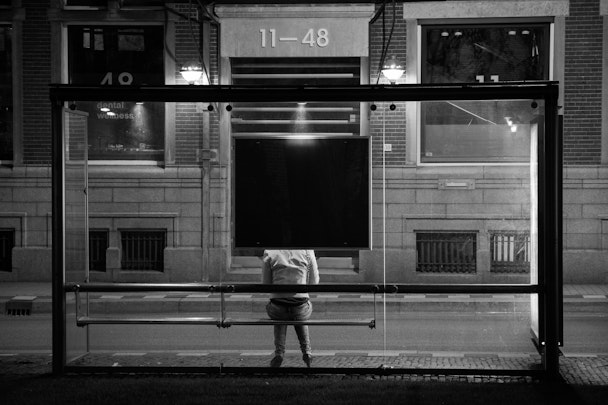Aesop Storytelling Series – Episode 6: Stay on the fucking bus
In June 2004, Finnish photographer Rafael Minkkinen stepped up to the microphone at the New England School of Photography to deliver the commencement speech. He shared a theory based on his Nordic hometown’s frenetic Bus Station, a philosophy that, in his opinion, made all the difference between success and falling short.

Stay on the f*cking bus.
There are two dozen platforms at Helsinki Bus Station, Minkkinen explained, from each of which several different bus lines depart. Thereafter, for a kilometre or more, all the lines leaving from any one platform take the same route out of the city, making identical stops. "Each bus stop represents one year in the life of a photographer," Minkkinen says. You pick a career direction – maybe you focus on making platinum prints of nudes – and set off. Three stops later, you've got a nascent body of work. "You take those three years of work on the nude to a gallery, and the curator asks if you are familiar with the nudes of Irving Penn". Penn's bus, it turns out, was on the same route. Annoyed to have been following someone else's path, "you hop off the bus, grab a cab… and head straight back to the bus station, looking for another platform". Three years later, something similar happens. "This goes on all your creative life: always showing new work, always being compared to others." What's the answer? "It's simple. Stay on the bus. Stay on the fucking bus."
Stay on the fucking bus. Success comes down to a magical combo of consistency and persistence. Sounds simple enough, right? So why is it that we marketers feel the need to hop off before a campaign has reached the end of its route?
Marketing consultant Peter Field revealed in ‘The Long and Short of It’ that short-termism in advertising is highly detrimental to effectiveness, yet marketers continue to tire of their own work quickly, deciding to discontinue ads before they have entered common consciousness. Field’s report also explained that emotional campaigns are more than twice as efficient as rational ones, with feelings towards brands outlasting memories of facts and figures. So why do we give up on brand stories before they have delivered their full emotional impact?
Here’s the thing – not all stories can be told in one chapter. For consumers to really engage with a brand story, they need to be exposed to it for a longer time.
Take Star Wars – when the original was released in 1977, it was not a box office smash hit. People had not encountered the unique components that mold to form the Star Wars ‘world’, so had not yet fully invested in the story. Only after seeing the first movie could they identify all the insider narrative cues in every film to follow. Same with Bond… James Bond. The reason it has become such a commercially successful franchise is its cocktail of consistent ingredients (shaken, not stirred). If Bond was introduced in 2017 with its original formula of bikini babes and cheesy jokes, it would be ridiculed. Instead, they are such an integral part of the franchise’s mythology that millions of people rush to see how these original components have evolved to suit the modern age in the latest release.
Heather Andrew at Neuro-Insight reckons that brands should "furnish the brand room in our heads" by using storytelling to build brand association. This is something that takes time and multiple executions: no one can furnish a room with only one piece of furniture. Brands therefore should take inspiration from 007 and stick to a long-term narrative structure, repeating their core story in different but recognisable guises.
Research from KANTAR Millward Brown supports re-emphasising the same idea to embed a brand story because “working the way people’s brains do also means restricting the number of key messages delivered”.
Some advertisers are already doing this, combining compelling, long-term storytelling with a single-minded benefit message. John Lewis, using the platform ‘The Home of Thoughtful Gifting’, has repeated its magical storytelling formula each Christmas and consequently become a UK Christmas institution alongside Slade and Quality Street. While each of JL’s stories work as individual films, their accumulative power is the key to their brand story success. People know what’s coming, so engage with the familiar narrative formula and are reminded again of the department store’s consumer message. Marmite does the same. By rigidly sticking to its infamous ‘love it or hate it’ territory, people know to expect an irreverent ad centred on conflict. Apple, by dramatising individual features and showing how they benefit consumers’ daily lives, has managed to tell its brand story of ‘humanising technology’ for decades.
Even so, brands need to be careful not to just push the same message without responding to culture or the changing attitudes of its audience. Joseph Campbell in ‘The Hero with a Thousand Faces’ argued that despite their variety of environment and circumstance, the myths and legends of the world simultaneously enact the various forms of one common story. Brands should take heed of this theory and keep patiently finding different, culturally relevant ways to tell the same story.
So channel your inner Minkkinen and stay on the fucking bus. It’s consistent emotional brand storytelling that builds long-term equity.
Ed Woodcock is director of narrative at storytelling agency Aesop.
Content by The Drum Network member:

Aesop
Aesop - A creative agency powered by narrative thinking
A lot of agencies talk about storytelling. And, at face value, it’s what all advertising agencies...

